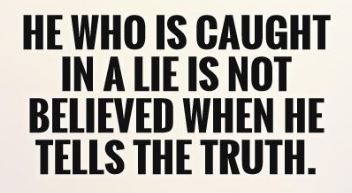The Truth About Fake News (original) (raw)
Growing up in pre-internet America, there were really only two ways to find out what was going on in the world.
Most homes in the neighborhood received the newspaper daily. Tossed at the door by a bike-riding paperboy and read by mom and dad over their morning coffee and toast, the paper contained all the news of the day. If it was printed in the paper it was trusted, the reader resting assured that a reporter, writer, and editor had done their homework and checked their facts before sending it to the presses.
Then there was the evening news. On TV's across the country, viewers could pick one of only three channels and watch the evening news at dinnertime, delivered to them by trusted anchormen like Walter Cronkite or Tom Brokaw. They delivered just the facts, an unbiased, factual delivery of the day's news that could be trusted.
Well, those days are over.
The number of Americans who read the newspaper is on the decline, and has been for years. Likewise fewer people get their news from the traditional nightly news programs that were once the pride of the big three networks.
The internet changed everything. Computers at our desk and devices in our hands now provide us with all the news we need, anytime we want it. We can catch up on the day's events over a coffee break, on the commute home, or while falling asleep, all with the simple push of a button or tap of a screen. No need to don a bathrobe and slippers to retrieve a soggy newspaper or wait until 6:30 PM for our favorite anchor to go live.
The Problem

While the internet and our constant access to it has made obtaining the days' news more convenient than ever, it comes with a big risk. Gone are the days of trusting that a reporter, writer, and editor had checked the facts, presenting you with news you could trust. Links on social media and other sites may look and sound trustworthy, legitimate, and believable, but are they?
Fake news is everywhere. We hear the phrase daily, from the White House on down. But where does it come from? How does it work? And is it really fake? Americans want to stay informed and learn about what's going on in the world from reliable sources, but can anyone be trusted anymore?
Let's take a deep dive into the world of fake news so you can learn to identify it when you see it.
RELATED: Is Mass Media Good or Bad?
What is Fake News?
Fake news is simply stories, reports, or posts that are purposely created by people desiring to misinform and mislead readers. Their goal is often to promote a political agenda, create confusion about an issue, and even to turn a profit for an online business.
Fake news reports are often highly deceptive, deliberately created to look like a legitimate news source and web address so that gullible readers will be duped. Not to be confused with the urban legends we grew up with, or even biased reporting, fake news is designed to mislead and deceive.
It's so easy to do, and we fall for it hook, line and sinker. Because we no longer rely on those trusted news sources but instead look to the internet, we can easily fall prey to fake news, even compounding the problem by spreading it ourselves!
Types of Fake News

There are several different kinds of fake news on the internet. Readers should beware of all of them. They include:
- Propaganda – News stories designed to disparage a candidate, promote a political cause, and mislead voters
- Sloppy Journalism – Stories containing inaccurate information produced by writers and editors who have not properly vetted a story. Retractions do little to fix the problem, even if there is one, since the story has spread and the damage done.
- Sensationalized Headlines – Often a story may be accurate but comes with a misleading or outrageous headline. Readers may not read past it, but take everything they need to know from this skewed title.
- Clickbait – These stories are deliberately created to create traffic on a website. Advertising dollars are at stake, and gullible readers fall for it by the millions.
- Satire – Parody websites like The Onion and The Daily Mash produce satirical stories that are believed by uninformed readers. The stories are written as satire and not meant to be taken literally, but not everyone knows that.
- Average Joe Reporting – Sometimes a person will post an eyewitness report that goes viral, but it may or may not be true. The classic example of this was a tweet by Eric Tucker in Austin, Texas in 2015. Posting a picture of a row of charter busses, Tucker surmised and tweeted that Trump protesters were being bussed in to rally against the President-elect. The tweet was picked up by multiple media outlets, and Mr. Trump himself, going viral in a matter of hours. The only problem is, it wasn't true.
It's so easy to be fooled by these types of fake news stories. Even legitimate news agencies can be duped.

Just recently, The Washington Post ran a story referring to the Green Day song "American Idiot" claiming it was written about President George W. Bush; the song is really about the American people being duped by the media. The only problem is they were citing a website called clickhole.com, a satirical website. The story was fake, designed to go viral and increase revenue. The Post was forced to make an embarrassing retraction, and wipe the egg from its face. You see this done countless times in the days of President Trump. CNN has especially been hit hard by the term “fake news”.
How it Spreads

News stories abound on social media sites like Twitter and Facebook. A headline catches your eye, you click and read, then click and share. It's that fast and that easy.
What if what we're unknowingly reading and sharing is fake news? If it seems like fake news is shared more readily than legitimate stories, it's because it's true.
While we'd like to think that it's Russian operatives, corrupt politicians, or even digital robots spreading fake news stories, a recent, groundbreaking study by MIT proved that the culprit is actually us.
The eye-opening study looked at every contested news story shared on Twitter over its ten year existence and concluded that truthful, accurate stories can't compete with fake news. False stories spread faster, traveled further, and lasted longer every time. People simply shared fake news more than real news, 70% more, spreading it like wildfire across the internet.
Why is this happening? Not surprisingly, fake news stories are more novel, interesting, and provocative than real news. They evoke emotion, and often uphold our biases and beliefs, making us more inclined to share them.
Another problem with fake news is that the more we are exposed to it, the more likely we are to believe it. The "illusory truth effect" is at play, a well studied psychological phenomenon that has proven for decades that the more we hear something, the more we believe it, whether it's true or not.
A recent study proved that readers exposed to a fake news story multiple times believed it over time. It seems we are growing immune to it the more we are exposed to it.
How to Spot Fake News
You know it's out there, but how can you identify it and keep from getting duped? Here are some things to consider:
- Read beyond the headline – A shocking, provocative headline might be just that. Read the entire article before believing and sharing it.
- Know the source – Be sure the website you are on is an actual, legitimate news source. Many fake news sites are designed to look like real ones, even having a url just a letter or two different from its legitimate counterpart.
- Check the date – Some articles may have been accurate when they were written, but after floating around on the internet for months or years are now outdated and inaccurate.
- Question the intent – As you read an article, beware of hidden agendas. Is the article designed to sell you something, get you to believe something, or even be shocked or amused? If so, it's probably fake news.
- Check your own biases – So often we are inclined to take something as fact when it confirms our preexisting beliefs.
- Do your own fact checking. We could once trust journalists to do this for us, but in the age of fake news we have to be willing to do it ourselves. If something seems unbelievable, it might just be. Use a fact checking site like FactCheck.org to investigate the validity of a story, especially before you share it. Try sticking to non-partisan resources if possible; again tough to know these days.
Stopping Fake News

Google and Facebook have both recently announced measures designed to quell the spread of fake news. Other internet giants and news organizations are following suit with new flagging tools and reporting protocols.
While these steps are important, stopping fake news in its tracks will depend mostly on the average reader using critical thinking skills and common sense. It is especially important for people to fact check an article before sharing it. While this may not solve the problem overnight, it will certainly keep from adding to it.
Fake news is everywhere. Learn to spot it and stop it in its tracks.
Considering a career in communications? Learn more about media communications graduate programs and mass communication graduate programs.